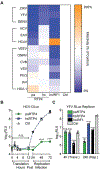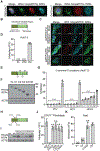RTP4 Is a Potent IFN-Inducible Anti-flavivirus Effector Engaged in a Host-Virus Arms Race in Bats and Other Mammals
- PMID: 33113352
- PMCID: PMC7666060
- DOI: 10.1016/j.chom.2020.09.014
RTP4 Is a Potent IFN-Inducible Anti-flavivirus Effector Engaged in a Host-Virus Arms Race in Bats and Other Mammals
Abstract
Among mammals, bats are particularly rich in zoonotic viruses, including flaviviruses. Certain bat species can be productively yet asymptomatically infected with viruses that cause overt disease in other species. However, little is known about the antiviral effector repertoire in bats relative to other mammals. Here, we report the black flying fox receptor transporter protein 4 (RTP4) as a potent interferon (IFN)-inducible inhibitor of human pathogens in the Flaviviridae family, including Zika, West Nile, and hepatitis C viruses. Mechanistically, RTP4 associates with the flavivirus replicase, binds viral RNA, and suppresses viral genome amplification. Comparative approaches revealed that RTP4 undergoes positive selection, that a flavivirus can mutate to escape RTP4-imposed restriction, and that diverse mammalian RTP4 orthologs exhibit striking patterns of specificity against distinct Flaviviridae members. Our findings reveal an antiviral mechanism that has likely adapted over 100 million years of mammalian evolution to accommodate unique host-virus genetic conflicts.
Keywords: antiviral immunity; bats; evolution; flavivirus; genetic arms race; interferon; restriction factor; virus-host interactions.
Copyright © 2020 Elsevier Inc. All rights reserved.
Conflict of interest statement
Declaration of Interests The authors declare no competing interests.
Figures





Comment in
-
Antiviral Effector RTP4 Bats against Flaviviruses.Immunity. 2020 Dec 15;53(6):1133-1135. doi: 10.1016/j.immuni.2020.11.019. Immunity. 2020. PMID: 33326764 Free PMC article.
References
-
- Baker FB (1974). Stability of Two Hierarchical Grouping Techniques Case I: Sensitivity to Data Errors. Journal of the American Statistical Association 69, 440–445.
Publication types
MeSH terms
Substances
Grants and funding
LinkOut - more resources
Full Text Sources
Research Materials

